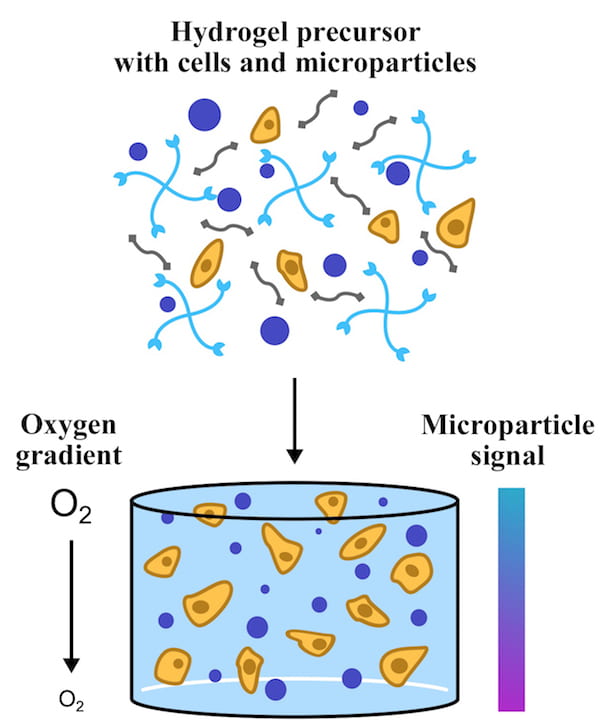NEWS RELEASE
Editor’s note: Links to high-resolution images for download appear at the end of this release.
David Ruth
713-348-6327
david@rice.edu
Mike Williams
713-348-6728
mikewilliams@rice.edu
Soft micro-monitors keep tabs on oxygen in new tissues
Rice University scientists develop fluorescent sensors to track nutrients in hydrogel-based healing
HOUSTON – (July 25, 2019) – It’s important to know one’s new cells are getting nourishment. Rice University scientists are working on a way to tell for sure.
The Rice lab of bioengineer Jane Grande-Allen has invented soft microparticle sensors to monitor oxygen levels in hydrogels that serve as scaffolds for growing tissues.
Hydrogels being developed at Rice’s Brown School of Engineering and elsewhere can be placed at the site of an injury. Seeded with live cells, they encourage the growth of new muscle, cartilage or, perhaps someday, entire organs. Ideally, the hydrogel attracts blood vessels that infuse the material and bring nourishment to the cells.

Rice University bioengineers developed fluorescent microparticles that can be suspended in hydrogel scaffolds seeded with live cells. The microparticles can be used to monitor for the presence of oxygen in hydrogel cultures that help injuries heal. Illustration by Reid Wilson
Grande-Allen and her team designed their fluorescent particles to report on oxygen levels inside gels. Their work appears in the American Chemical Society journal ACS Biomaterials Science and Engineering.
“We’ve been collaborating with investigators in intestinal mechanobiology and wanted a straightforward way to tell what level of oxygen we had throughout our 3D tissue cultures,” Grande-Allen said. “Where we intend a specific level of oxygen, we want to be sure that’s what the cells are getting.
“There are multiple ways of doing this,” she said. “We can have computational models, but we’d have to make several assumptions about the way oxygen permeates the culture medium and 3D scaffold material. A better way is to measure it directly, so that was our goal.”

Reid Wilson
Lead author Reid Wilson, an M.D./Ph.D. student at Rice and Baylor College of Medicine, built on the work of Rice alumnus Matthew Sapp and Rice graduate student Sergio Barrios to develop soft microparticles that that incorporate an oxygen-triggered fluorescent molecule based on palladium and a reference fluorophore.
Wilson went through several iterations of dye combinations and concentrations to develop those microparticles. “The problem with using oxygen-responsive fluorophores in three-dimensional cultures is their signal isn’t bright enough to measure reliably,” he said. “So we loaded the microparticles with high concentrations of dye, which allowed more reproducible measurements of the oxygen concentration.”
The particles can be suspended in hydrogel along with living cells, and tests showed they are not toxic to those cells. Signals from the fluorescent components can be read at their individual wavelengths, but their power lies in combining the response from both, which gives clinicians the ability to measure oxygen content as far as 2 millimeters into tissues.
“That’s small, but oxygen diffusion limits are usually tiny,” Grande-Allen said. “Some cells are quite close to a blood supply, with a high oxygen level brought in by blood cells with hemoglobin. But some bacteria in the microbiome are normally anaerobic and survive better without oxygen.”

Jennifer Connell
Grande-Allen said the particles aren’t susceptible to photobleaching (fading) when illuminated at the proper wavelength, nor did they sink out of the hydrogel, as larger fluorescent particles were prone to do, even after a year in storage.
She noted that tissues like cartilage and certain types of diseased heart valves don’t have vascular networks, yet their cells thrive. “I’ve always wondered how these cells get nourishment and what they need to survive,” she said. “With oxygen-sensing microparticles and other techniques we use in my lab to stretch living and engineered materials, we can start to work toward answering these questions.”
Rice research scientist Jennifer Connell is co-author of the paper. Grande-Allen is a professor of bioengineering and chair of the Rice Department of Bioengineering.
The National Institute of Allergy and Infectious Disease and the National Institute of Diabetes and Digestive and Kidney Diseases supported the research.
-30-
Read the abstract at https://pubs.acs.org/doi/10.1021/acsbiomaterials.9b00257
Follow Rice News and Media Relations via Twitter @RiceUNews
Related materials:
Molecular bait can help hydrogels heal wounds: http://news.rice.edu/2019/06/05/molecular-bait-can-help-hydrogels-heal-wounds-2/
Organ bioprinting a breath of fresh air: http://news.rice.edu/2019/05/02/organ-bioprinting-gets-a-breath-of-fresh-air/
Rice pursues endgame for diabetes: http://news.rice.edu/2018/10/08/rice-u-pursues-end-game-for-diabetes-2/
Slow-release hydrogel aids immunotherapy for cancer: http://news.rice.edu/2018/03/07/slow-release-hydrogel-aids-immunotherapy-for-cancer-2/
Grande-Allen Integrative Matrix Mechanics Lab: https://grandegroup.blogs.rice.edu
Rice Department of Bioengineering: https://bioengineering.rice.edu
Rice Institute of Biosciences and Bioengineering: https://ibb.rice.edu
Image for download:
https://news2.rice.edu/files/2019/07/0729_OXYGEN-1-WEB.jpg
Rice University bioengineers developed fluorescent microparticles that can be suspended in hydrogel scaffolds seeded with live cells. The microparticles can be used to monitor for the presence of oxygen in hydrogel cultures that help injuries heal. (Credit: Reid Wilson/Rice University)
Located on a 300-acre forested campus in Houston, Rice University is consistently ranked among the nation’s top 20 universities by U.S. News & World Report. Rice has highly respected schools of Architecture, Business, Continuing Studies, Engineering, Humanities, Music, Natural Sciences and Social Sciences and is home to the Baker Institute for Public Policy. With 3,962 undergraduates and 3,027 graduate students, Rice’s undergraduate student-to-faculty ratio is just under 6-to-1. Its residential college system builds close-knit communities and lifelong friendships, just one reason why Rice is ranked No. 1 for lots of race/class interaction and No. 2 for quality of life by the Princeton Review. Rice is also rated as a best value among private universities by Kiplinger’s Personal Finance.


